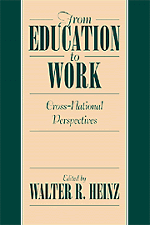Book contents
- Frontmatter
- Contents
- Contributing Authors
- Preface
- Introduction: Transitions to Employment in a Cross-National Perspective
- Part I Social Origin, Gender, and Transition Patterns
- Part II Education and Labour Markets: Work Experiences, Skills, and Credentials
- 5 Adolescent Part-Time Work and Postsecondary Transition Pathways in the United States
- 6 Multiple Life-Sphere Participation by Young Adults
- 7 The Subbaccalaureate Labor Market in the United States: Challenges for the School-to-Work Transition
- 8 Creating New Pathways to Adulthood by Adapting German Apprenticeship in the United States
- 9 Job-Entry Patterns in a Life-Course Perspective
- Part III Changes in the Social Context of Transitions
- References
- Index
5 - Adolescent Part-Time Work and Postsecondary Transition Pathways in the United States
Published online by Cambridge University Press: 30 September 2009
- Frontmatter
- Contents
- Contributing Authors
- Preface
- Introduction: Transitions to Employment in a Cross-National Perspective
- Part I Social Origin, Gender, and Transition Patterns
- Part II Education and Labour Markets: Work Experiences, Skills, and Credentials
- 5 Adolescent Part-Time Work and Postsecondary Transition Pathways in the United States
- 6 Multiple Life-Sphere Participation by Young Adults
- 7 The Subbaccalaureate Labor Market in the United States: Challenges for the School-to-Work Transition
- 8 Creating New Pathways to Adulthood by Adapting German Apprenticeship in the United States
- 9 Job-Entry Patterns in a Life-Course Perspective
- Part III Changes in the Social Context of Transitions
- References
- Index
Summary
In the contemporary United States, part-time employment during the high school years has become an integral part of the “new passage” between education and work. Unlike the situation in Germany, Japan, and other countries, adolescent part-time work occurs in the context of a relatively unstructured school-to-work transition (Hamilton, 1990; Rosenbaum, Kariya, Settersten, & Maier, 1990). That is, in the United States, there is relatively little institutional support for young people as they embark on their job searches on completing their formal educations. This is especially true for those who do not complete a 4-year college degree (William T. Grant Foundation, 1988). In view of the high youth unemployment rates that result from this situation (Petersen & Mortimer, 1994), new initiatives to heighten the linkage between school and work, with support from the federal government, are now being developed (Borman, Cookson, Sadovnik, & Spade, 1996). Most youth, however, lack such support and must find out about the world of work – and forge their entry to the labor market – on their own.
Without the benefit of apprenticeship programs or strong connections between schools and employers, almost all high-school students in the United States obtain employment in the “youth labor market,” consisting largely of service-sector jobs, even before leaving high school (Manning, 1990).
- Type
- Chapter
- Information
- From Education to WorkCross National Perspectives, pp. 111 - 148Publisher: Cambridge University PressPrint publication year: 1999
- 17
- Cited by



